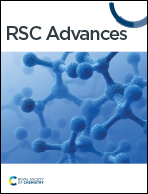One-step fabrication of three-dimensional macropore copolymer-modified polycarbonate array by photo-crosslinking for protein immunoassay†
Abstract
A photocross-linked copolymer was prepared, and could rapidly form a macropore structure in phosphate buffer solution (PBS) without the addition of porogen. The photo-crosslinking process contained the crosslinking of the copolymer itself and that with the polycarbonate substrate. The three-dimensional (3D) surface was achieved through one-step photo-crosslinking of the macropore structure. The macropore structure can be finely regulated by multiple dimensions, including monomer structure of the copolymer, PBS and copolymer concentration. Compared with the two-dimensional (2D) surface, the 3D surface has a controllable structure, a high loading capacity (59 μg cm−2) and immobilization efficiency (92%), and the effect of inhibiting the coffee ring for protein immobilization. Immunoassay results show that a 3D surface immobilized by IgG has high sensitivity (LOD value of 5 ng mL−1) and broader dynamic range (0.005–50 μg mL−1). This simple and structure-controllable method for preparing 3D surfaces modified by macropore polymer has great potential applications in the fields of biochips and biosensing.



 Please wait while we load your content...
Please wait while we load your content...